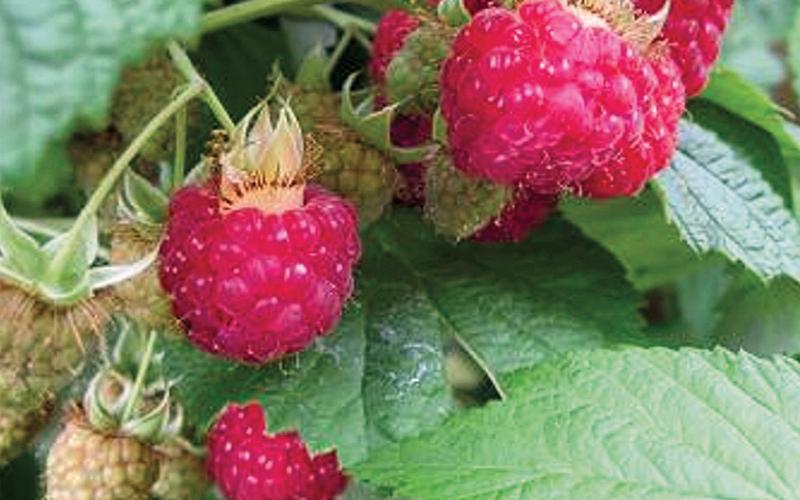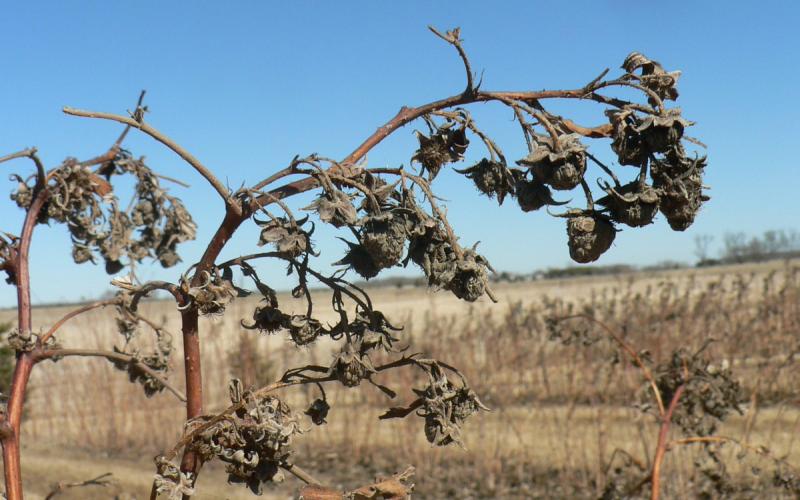Written by Rebekah White, SDSU Agriculture Leadership, Education, Communication and Science Department undergraduate student, under the direction and review of Kristine Lang, Assistant Professor, and Rhoda Burrows, former Professor & SDSU Extension Horticulture Specialist. Special thanks to Jack Farquhar and CJ Calmus for peer review of this publication.
Introduction to Raspberries

Raspberries are a part of the genus Rubus, which is in the Rose family, and they are brambles. Raspberries are a cool-season crop. The raspberry plant itself is perennial, but the canes are biennial. In their first year, they are called primocanes, and after they overwinter, they are called floricanes. After floricanes fruit, they die back and can be removed. The plant produces new primocanes each year. Primocanes are green, new growth, and floricanes are brown, woody second-year growth.
There are two main types of raspberries, fall-fruiting and summer-fruiting. Fall-fruiting bear fruit on both primocanes and floricanes, while summer-fruiting bear only on floricanes.
There were 8 acres of raspberry crops grown commercially in South Dakota in 2017.
Types of Raspberries
Red
Red raspberries (Rubus ideaus) include both summer-bearing and fall-bearing types.
- Common hardy summer-bearing varieties: Boyne, Nova, Encore.
- Common fall-bearing varieties: Autumn Bliss, Caroline, Polana.
Purple
Purple raspberries are crosses between red and black raspberries and are intermediate in hardiness between red and black raspberries.
- Common variety: Royalty
- Traits: Semi-hardy; large, thorny plants; sweet fruit
- Purple raspberries are damaged at temperatures below -20 degrees Fahrenheit. They are better for preservation than eating off the cane.
Yellow
Yellow raspberries tend to be sweeter, and they are all fall-bearing types.
- Common hardy variety: Fall Gold.
- Yellow fruit are more prone to discoloration caused by disease or mechanical damage.
Black
Black raspberries (Rubus occidentalis) have canes that generally die back during South Dakota winters. The hardiest variety is Jewel.
- Most black raspberries don’t survive South Dakota winters, as they are damaged at temperatures below -15 degrees Fahrenheit.
- They are also more susceptible to anthracnose.
Managing Raspberry Quality
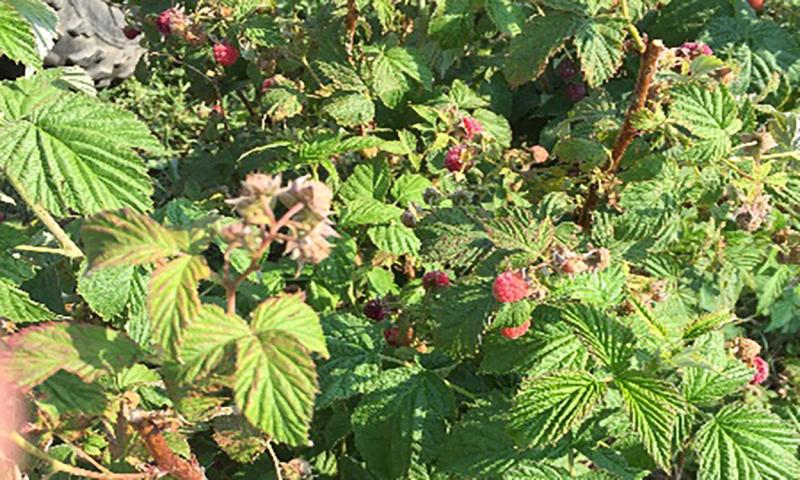
Planting
Raspberries need to be planted in an area with full sunlight that has good soil drainage. Although the site should have good air movement to prevent disease problems, it shouldn’t be very windy, as raspberry canes are sensitive to drying out. Plants need to be watered, as the roots are all in the top two feet of soil, but the ground should not be soggy. See Table 1 for additional planting recommendations.
To prevent diseases from getting into the raspberries, prepare the beds against weeds a year ahead of time if possible. Buy all the raspberry plants disease-free from reputable nurseries. Mulch will keep moisture in the ground and weeds out, as well as increase the organic matter in the soil over time. Put a fence up over winter to keep out rabbits, or they may eat the canes down to the ground, preventing fruiting of summer-bearing varieties.
|
Variety type |
Distance Within Row |
Distance Between Rows |
Trellis Required? |
|---|---|---|---|
| Red and Yellow |
|
|
|
| Purple |
|
|
|
Pruning
Summer-bearing red raspberries should be pruned in March or early April. Remove dead, diseased, spindly, and injured canes. Then thin canes so there are canes every 6 to 8 canes per foot, per row. Fall-fruiting raspberries can be mowed or cut 1 to 2 inches above the ground. For more information on how to prune raspberries, see SDSU Extension’s publication, Growing Raspberries in South Dakota.

Diseases
Common raspberry diseases include soil-born phytophthora and verticillium wilt, both common in poorly drained soils. Anthracnose is a disease that infects the stem, and gray mold infects the fruit. Good air circulation and removal of diseased canes will reduce disease and insect problems. Viruses can reduce fruit size or cause crumbly fruit.
Pests
Common pests to raspberries on the leaves and canes include aphids, raspberry cane borer and spider mites. Pests to raspberry fruit include sap beetles, Asian lady beetles, spotted-wing drosophila, and tarnished plant bugs. For more information on insects and diseases, see SDSU Extension’s publication, Growing Raspberries in South Dakota.
When to Harvest Raspberries
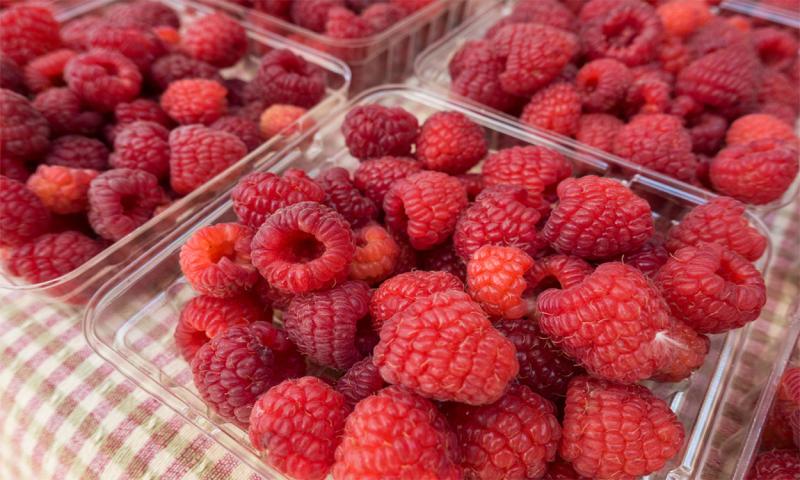
Raspberries are harvested when the colors are developed, and the fruit is soft. Another good indicator is when the fruit separates easily from the plant when pulled gently. The berries will not all ripen at the same time, so there will be multiple harvests. Raspberries are typically harvested every two to four days until plants stop bearing fruit.
Harvest usually occurs in mid-summer for summer-fruiting types. For fall-fruiting types, you can potentially get two crops from the plants. Fall-fruiting crops are ready for harvest in the fall, and then, if not cut back, produce a smaller harvest on the same canes in July of the next year.
If you harvest too early, the raspberries won’t be ripe and may not be well-colored enough to sell at U.S. Number 1 quality. If you wait too long to harvest and the fruit gets overripe, you will start to attract pests, such as picnic beetles and other insects, which are attracted to all types of overripe fruit. Be sure to remove any fallen fruit, as insect pests will breed in ripening fruit.
How to Harvest Raspberries

When picking raspberries, use a shallow container, as a deep container will crush the raspberries on the bottom. If you use single-use containers, you can use the containers you picked into for selling at the farmers market or other venues. All berries will be picked by hand, put into shallow containers, and then taken directly to be cooled. The raspberries should be covered in the cooler to prevent excess condensation from causing the raspberries to mold. Do not wash the fruit during harvest, as this will cause the raspberries to start breaking down. The raspberries should be as dry as possible going into the fridge.
Cleaning Raspberries
Raspberries are field packed and are not washed on the farm. The berries should be covered in storage to keep extra condensation out.
Do not wash raspberries until you are ready to eat them, as washing them makes them start to break down, and they will have a very short shelf life. They should be washed before they are eaten, however, because they are eaten raw, and they have lots of crevices for dirt and other contaminants to hide.
Sorting and Marketability of Raspberries
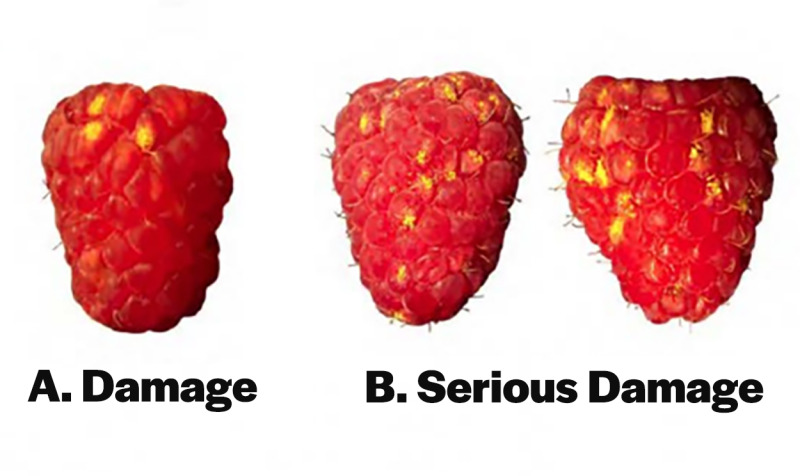
A marketable raspberry for direct sale to a customer is a raspberry of one variety that is well-developed and well-colored. This means that it’s free from damage caused by sunscald, mold, foreign matter, insects, mechanical or other means, disease, or decay. It also means that it’s not soft, broken, or overripe.
The tolerances for U.S. Number 1 direct sales are: No more than 10% by volume may fail to meet the requirements, with no more than 5% being affected with serious defects, and in that 5%, no more than 1% having mold or decay.
When marketed for processing, the requirements are very similar, but the tolerances are different. For processing, the tolerances for U.S. Number 1 are: No more than 5% by weight can fail to meet the requirements, and no more than 1% can be affected by mold, decay, or seriously damaged by insects.
Harvest and Post-harvest Food Safety
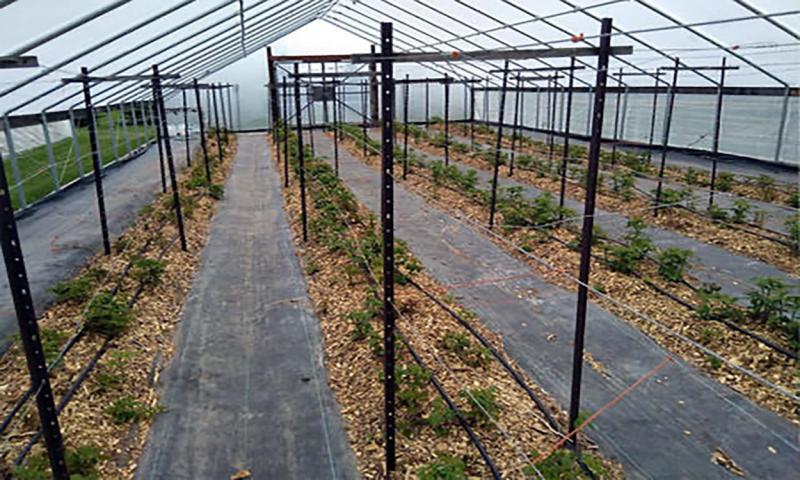
Raspberries are formed with lots of drupelets. This creates lots of cracks and crevices for dirt and other contaminants to get into the fruit during growth and harvest. The fruit is eaten raw most of the time, so keeping the crops as clean as possible is an important management practice.
Keeping the fruit off the soil makes it easier to keep the dirt out of the cracks in the raspberries. The trellis system will help for most varieties, but purple varieties don’t usually require a trellis.
As raspberries are picked by hand, proper hand washing procedures must be used so that no diseases travel to the crops or between crops because of the human workers. Harvest containers should either be single-use or properly cleaned and sanitized.
On-farm Storage of Raspberries
Raspberries can be stored in the shallow containers they were picked in. The refrigeration unit should maintain a temperature between 32 and 36 degrees Fahrenheit with a humidity between 90% to 95%. The fruit may also be frozen immediately for the best quality. This would be helpful if you want to sell the raspberries frozen or if you want to process them later as a value-added product. Only wash the fruit before use, not storage. Washing fruit before storage will cause molding. Cover the fruit before it goes into storage to reduce the amount of condensation that can reach it to reduce the risk of mold. Red and purple raspberries that were cooled immediately after picking can be stored for up to seven days. Yellow raspberries can only be stored for three days. If not put into storage, the raspberries break down rapidly and they will not last long. For best results, transport under refrigeration.
Marketing Raspberries
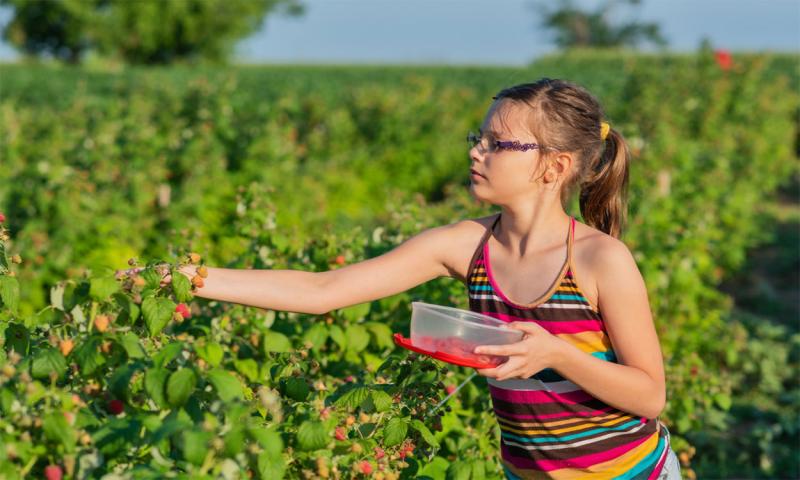
One way to market raspberries is as a pick-your-own operation; customers love to pick their own berries. Marketing the experience as well as the fruit is a great way to get business. Another way to market is at the farmer’s market, as people like to buy fresh local fruit. You could also sell the raspberries in value-added products, such as jams and jellies at the farmers market to extend the season or the shelf life of the raspberries. If there are any smoothie shops in town, you could sell them fresh or frozen raspberries so they could support local farms and you would have a steady customer. You could also sell to the local grocery store and help them get fresher fruit on their shelves.
References
- Burrows, R. & Fennell, A. (2020, March). Growing Raspberries in South Dakota. South Dakota State University Extension.
- Penn State Extension. (n.d.). Raspberry planting and care for Home Gardeners. Penn State Extension. Retrieved November 8, 2022.
- Reich, J., Hughes, H., & Ells, J. E. (n.d.). Raspberries for the Home Garden – 7.001. Retrieved November 8, 2022.
- Sønsteby, A. & O. M. Heide (2009) Effects of photoperiod and temperature on growth and flowering in the annual (primocane) fruiting raspberry (Rubus idaeus L.) cultivar ‘Polka’, The Journal of Horticultural Science and Biotechnology, 84:4, 439-446, DOI.
- United States Department of Agriculture. (n.d.). Raspberries for Processing Grades and Standards. Agricultural Marketing Service. Retrieved November 16, 2022.
- United States Department of Agriculture. (n.d.). Raspberries Grades and Standards. Agricultural Marketing Service. Retrieved November 16, 2022.
- United States Department of Agriculture. USDA Census of Agriculture. pg. 35 (2017).
- University of Minnesota Extension. (n.d.). Growing raspberries in the Home Garden. UMN Extension. Retrieved November 8, 2022.
